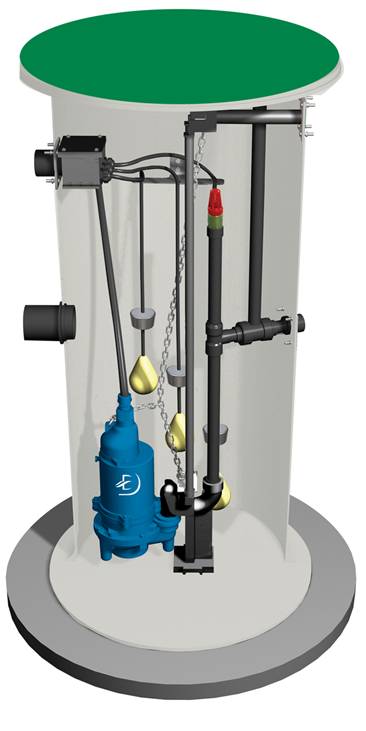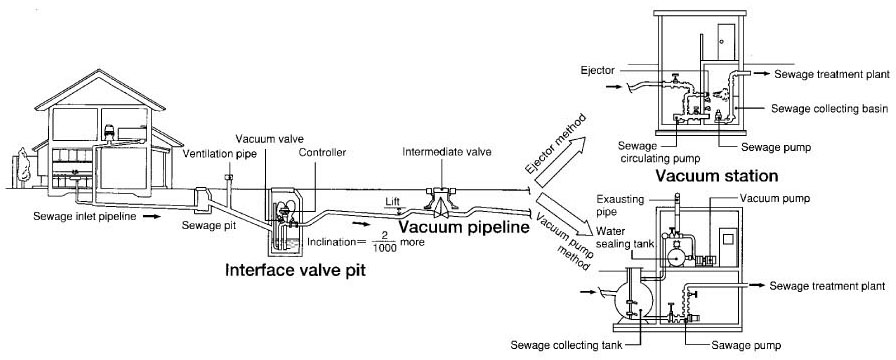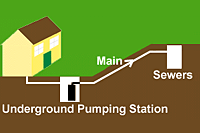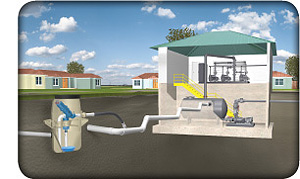

TYPES OF SEWERS
Need for Alternate Types of Sewers
Installation of conventional sewerage system is not possible in many situations due to the following reasons:
- The per capita water supply (including the local and individual sources) to the population is less than the minimum requirement of water supply for the efficient performance of the sewerage system, i.e., 100 Lpcd. This will cause the operation and maintenance problems with frequent clogging, due to silting in the absence of self cleansing velocity;
- The topography of the town is flat necessitating deeper excavation of trenches and more number of sewage pumping stations,
- Either ground water table is high or the substrata are made up of hard rock, leading to difficult construction of sewerage system.
Hence, suitable alternate types of sewerage systems which will overcome the above problems are to be adopted.
The following types of alternate sewerage systems have been adopted successfully in different situations in developed countries:
- Pressure sewer system,
- Vacuum sewerage system,
- Small diameter gravity sewers
Pressure Sewer System
In pressure sewer system the entire system will function as a pressure system similar to water supply distribution system with full flow condition in the conduits.
The important features of the pressure sewer system are as follows:
- Individual household shall pump wastewater into a public pressure sewer system,
- The system shall have a network of pressure conduits with sufficient capacity to carry pumping flow with due consideration for coincidental inflow from number of houses.
- System design should consider pressure limitations of joints, tees, fittings, etc. The system should be provided with backflow preventor on all house connection lines.
Sufficient number of isolation/shut-off valves should be provided to minimize inconvenience during service/repairs.
All valves, piping, fittings, appurtenances should be of high quality durable material, capable of withstanding service pressures.
Piping should be installed at adequate depths not deeper than 1.50 m to prevent damage from other activities.
The pressure sewer conduits should be differentiated from water supply lines by distinct colour and separated by at least 3 m distance horizontally and o.45 m vertically. The sewer • line should be laid below water supply line.
Advantages of Pressure sewer systems are:
- Pressure sewer pipes, besides being smaller in diameter are installed at shallower depths than conventional sewers,
- They need not be laid on a precise grade as in gravity sewers, but can often go over hill below the hydraulic gradient line.
- Since there are no elements such as access manholes and sewer line is under pressure, the inflow from storm runoff is virtually eliminated.
- The system is cheaper than conventional sewerage where unfavourable conditions prevail.
Disadvantages of Pressure sewer system
- They are to be differentiated from the water supply distribution system with proper colour code,
- Awareness among the public is required about the hazard risk of the pressure sewer system if they are tampered.
- Each and every house should have a collection sump and pumping facilities.
Components of Vacuum Sewerage System
Domestic shaft: It is the collection sump at the house. The wastewater from the domestic shaft is discharged into the vacuum pipe network in specified quantities.
Pipe network: It is the system where vacuum is created for the transport of the wastewater from the domestic shaft to the pumping station.
Pumping station: Pump station is located at the centre of the catchment. At the pumping station the vacuum for the wastewater conveyance from the domestic shaft is produced by vacuum pumps. From the pumping station the wastewater is pumped to the sewage treatment plant (STP).
Functions of the vacuum sewerage system
- The wastewater is being delivered by a gravity system to the pre tank of the domestic shaft.
- While the pre-tank being filled, an electronic sensor opens the interface valve. During the opening air flows into the mixing chamber and is being mixed with the wastewater and leaves the valve flowing into the vacuum pipe network as a water-air mixture.
- There are also pneumatically controlled valves that open and close depending on the vacuum in the pipe network.
- The vacuum pump produces a vacuum in the wastewater collection tank as well as the pipe network by which the wastewater is sucked from the pipe network to the collection tank at the pumping station.
- The vacuum continues throughout the pipes up to the domestic shafts.
- When one of the two wastewater tanks at the pumping station is filled the vacuum line of the area closes down.
- From the wastewater tank of pump station the wastewater is pumped to the wastewater treatment plant (WwTP) by the wastewater pumps.
- During this process the second tank takes over the function of collection through vacuum line in order to keep up the system functioning.
Domestic shaft with interface valve
Domestic shaft is the collection sump at the individual house. It is electronically controlled interface valve and automatic air intake
Requirements of the domestic shaft
- The shaft should be water tight, lift safe and of simple construction.
- The control valve should allow free flow to avoid energy loss and clogging up, opening independent of pressure, closing independent of external force, wastewater delivery with simultaneous addition of air, long-term durability and freedom from maintenance.
Important Consideration at Vacuum pumping stations
- Vacuum pumping stations are economically run at a vacuum of 0.6 bar in relation to the atmosphere. The vacuum at the domestic interface valve due to safety reasons should not to exceed 0.3 bar.
- The sum of the pipe friction loss and the difference in height should, therefore, not to exceed a value of 3.00 metre of water column
One Response to “TYPES OF SEWERS”
Leave a Reply










 LIKE TO GET UPDATES
LIKE TO GET UPDATES  TO GET EXPERT GUIDE
TO GET EXPERT GUIDE
which system you prefer for an OFFSHORE JACK UP BARGE a VACUUM SYSTEM or a Gravity type sewage syste ?
thanks